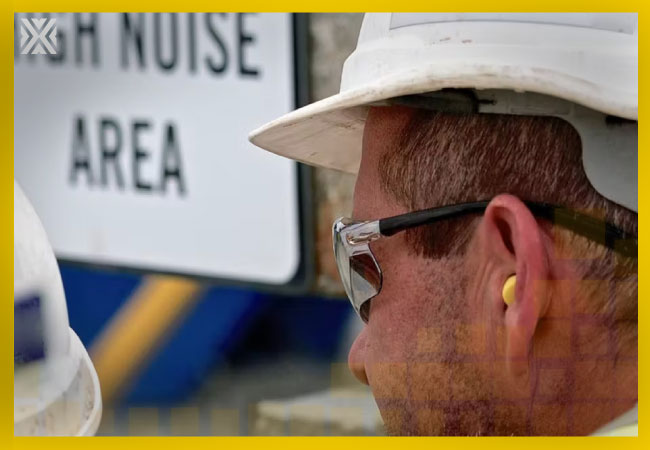Currency
June 28, 2022

Make sure all employees are aware of the hazards of noise-induced hearing loss, so they can take steps to protect against them.
Loud noises in the workplace can lead to permanent hearing loss among workers. Banging, drilling and other mechanical processes can produce loud noises that can damage a person’s eardrum. The types of sounds, noise intensity and duration of exposure can all contribute to hearing loss.
Symptoms may take years to develop, but even brief exposure to loud noises can have a major effect on a person’s life, limiting their ability to hear the world around them. Once noise-related hearing loss occurs, it is irreversible, so it’s crucial to protect your hearing when on the job and off, including when attending concerts and using loud tools or equipment at home.
The Occupational Safety and Health Administration (OSHA) has set clear rules regarding noise pollution in the workplace. If these sounds pass a certain threshold, managers should implement what’s known as a hearing conservation program to protect staff from permanent hearing loss.

Managers first need to understand how sound is measured in the workplace. Decibels (dB) are used to measure the intensity of sound. The higher the decibel, the louder the sound. For context, normal conversations occur at around 40 dB, while appliances like a hair dryer come in at around 70 dB. Meanwhile, a jetliner can be as loud as 140 dB.
Prolonged exposure to sounds above 85 dB and any exposure to sounds above 135 dB can cause permanent hearing damage. In addition to hearing loss, these noises can cause damage to the inner ear, which can lead to long-term ringing in the ears or tinnitus.
According to current OSHA guidelines, employers must implement a hearing conservation program if noise exposure is at or above 85 decibels averaged over 8 working hours, or an 8-hour time-weighted average (TWA). This doesn’t mean exposing workers to 85 dB for 8 hours straight. OSHA wants employers to average sound exposure over the 8-hour day. For example, if a worker is exposed to 100 dB of sound on and off for around two hours in an otherwise quiet workplace, they will likely still need a hearing conservation program during their shift if the average comes out to 85 dB or more.
To calculate the average, employers can add up the amount of time workers are exposed to different levels of noise. For example, a worker may be exposed to 50 dB for two hours, 70 dB for two hours, 90 dB for two hours and then another two hours of 50 dB. This comes out to an average of 65 dB over an 8-hour shift.
According to OSHA, hearing conservation programs should "strive to prevent initial occupational hearing loss, preserve and protect remaining hearing, and equip workers with the knowledge and hearing protection devices necessary to safeguard themselves.”
These programs can take many forms as long as they all work toward the same goal, which is to prevent hearing loss. Creating a hearing conservation program all depends on the workplace in question and the source of the noise. However, most programs include the following:
Hearing protection equipment comes in many different shapes and sizes. Managers should provide workers with a range of options, so they can choose the appropriate, securely-fitted equipment for the task at hand.
For example, electricians will often wear dielectric headphones to protect them from electrical hazards. This equipment is often inserted underneath or on top of other personal protective equipment. Workers may need to use bands or inserts underneath their helmets. In other cases, these devices may be mounted on the helmet or neck.
Loud noises in the workplace can lead to permanent hearing loss among workers. Banging, drilling and other mechanical processes can produce loud noises that can damage a person’s eardrum. The types of sounds, noise intensity and duration of exposure can all contribute to hearing loss.
Symptoms may take years to develop, but even brief exposure to loud noises can have a major effect on a person’s life, limiting their ability to hear the world around them. Once noise-related hearing loss occurs, it is irreversible, so it’s crucial to protect your hearing when on the job and off, including when attending concerts and using loud tools or equipment at home.
The Occupational Safety and Health Administration (OSHA) has set clear rules regarding noise pollution in the workplace. If these sounds pass a certain threshold, managers should implement what’s known as a hearing conservation program to protect staff from permanent hearing loss.

Measuring Sound
Managers first need to understand how sound is measured in the workplace. Decibels (dB) are used to measure the intensity of sound. The higher the decibel, the louder the sound. For context, normal conversations occur at around 40 dB, while appliances like a hair dryer come in at around 70 dB. Meanwhile, a jetliner can be as loud as 140 dB.
Prolonged exposure to sounds above 85 dB and any exposure to sounds above 135 dB can cause permanent hearing damage. In addition to hearing loss, these noises can cause damage to the inner ear, which can lead to long-term ringing in the ears or tinnitus.
Implementing a Hearing Conservation Program
According to current OSHA guidelines, employers must implement a hearing conservation program if noise exposure is at or above 85 decibels averaged over 8 working hours, or an 8-hour time-weighted average (TWA). This doesn’t mean exposing workers to 85 dB for 8 hours straight. OSHA wants employers to average sound exposure over the 8-hour day. For example, if a worker is exposed to 100 dB of sound on and off for around two hours in an otherwise quiet workplace, they will likely still need a hearing conservation program during their shift if the average comes out to 85 dB or more.
To calculate the average, employers can add up the amount of time workers are exposed to different levels of noise. For example, a worker may be exposed to 50 dB for two hours, 70 dB for two hours, 90 dB for two hours and then another two hours of 50 dB. This comes out to an average of 65 dB over an 8-hour shift.
According to OSHA, hearing conservation programs should "strive to prevent initial occupational hearing loss, preserve and protect remaining hearing, and equip workers with the knowledge and hearing protection devices necessary to safeguard themselves.”
These programs can take many forms as long as they all work toward the same goal, which is to prevent hearing loss. Creating a hearing conservation program all depends on the workplace in question and the source of the noise. However, most programs include the following:
- Workers should be aware of the risks of noise-induced hearing loss and other health risks that can occur due to noise exposure.
- If workers are potentially exposed to noise-induced hearing loss, they must be given a baseline audiogram within the first six months of work. Afterward, they should receive an annual audiogram performed by a certified audiologist, free of charge. They should then compare the results to those of the baseline audiogram to determine if noise exposure has caused hearing loss.
- Workers at risk of experiencing noise-induced hearing loss should be given various hearing protection options, including earplugs, earmuffs and headphones for reducing ambient sound.
- Employers must hold a hearing protection training program every year to make sure workers who will be exposed to more than 8 hours of 85-decibel noise know how to protect themselves on the job.
- Records must be kept of employees' varying noise exposure levels.
Hearing protection equipment comes in many different shapes and sizes. Managers should provide workers with a range of options, so they can choose the appropriate, securely-fitted equipment for the task at hand.
For example, electricians will often wear dielectric headphones to protect them from electrical hazards. This equipment is often inserted underneath or on top of other personal protective equipment. Workers may need to use bands or inserts underneath their helmets. In other cases, these devices may be mounted on the helmet or neck.









